"Armata" as a unified tracked platform
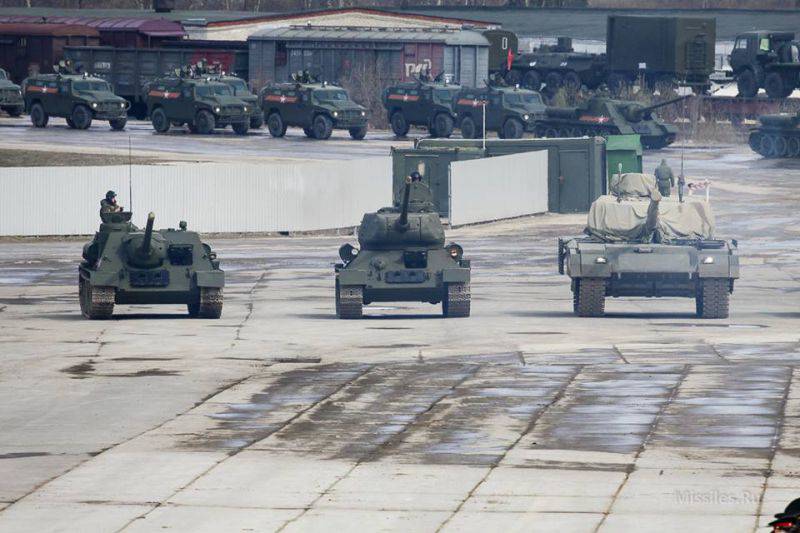
The advertising company, which is maintained by Uralvagonzavod in the media on the presentation of its products, which are part of the Armata UGP, causes a dual reaction.
On the one hand, it is possible to note the priority of UVZ in the development of the head product of the Armata family - tank T-14, with crew separated from ammunition and fuel. On the other hand, the claimed technical implementation of this idea is completely leveled by visible miscalculations regarding the layout of the tank and its security.
The first thing that catches your eye is the large, if not to say huge, dimensions of the T-14, which are clearly not in line with its weapons. For reasons that are inexplicable from the point of view of common sense and traditions of the national school of tank construction, the UVZ presented a machine that exceeds the size of any main battle tank, including foreign ones.
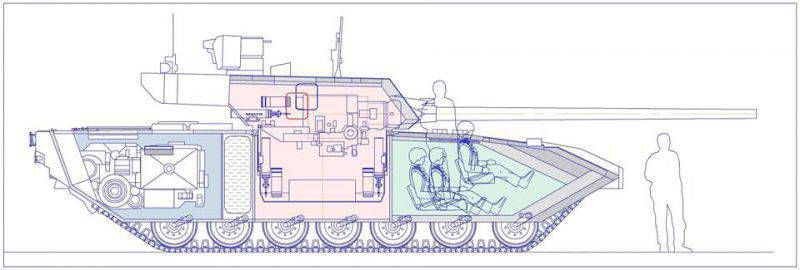
Zabronevy volume of the hull and turret T-14 is 20 cubic meters, which is almost two times more than the similar indicator T-90 (weighing 48 tons) and almost equal to the volume of Abrams M1A2 SEP (weighing 63,1 tons). If we equate the weight of the T-14 to the weight of the American tank, then the level of protection of the T-14 in comparison with the T-90 will be less by 50 percent. It may seem that T-14 is better protected in the frontal projection, however, this was not possible to achieve - the size of the area of the armored frontal surface is at the level of the American tank.
Representatives of the UVZ invariably remind of the arrangement in the so-called crew capsule in the T-14, which has additional protection compared to the hull of the tank. But watching the video frames of the reportage of the TV channel “Zvezda” does not confirm the presence of any additional armor obstacles in the control compartment, except for the frontal part and the sides of the body itself, which is not surprising given the longitudinal placement of three crew members. Consequently, the protection of tankers in the T-14 is at the same level as the protection of the tank itself (see above).
But, maybe, the reduced protection from the side of passive armor is compensated by the special properties of the active protection complex installed on T-14?
KAZ of the tank is a development of the Soviet Drozd complex, developed about forty years ago and installed on T-55AD tanks. This type of active protection with fixedly mounted launchers on the tower has two significant drawbacks:
- limited view of the protection of the tank, usually in sectors of 45 shelling degrees on either side of the axis of the gun;
- reduced kinetic impact on the attacking artillery shell / anti-tank missile / rocket grenade.
Limited sectors of firing of launchers force them to direct the tank turret at the target, which reduces the speed of the KAZ type Drozd by several orders of magnitude compared to alternative systems, and also removes the gun from the combat state for the duration of the turret rotation in order to intercept the attacking ammunition.
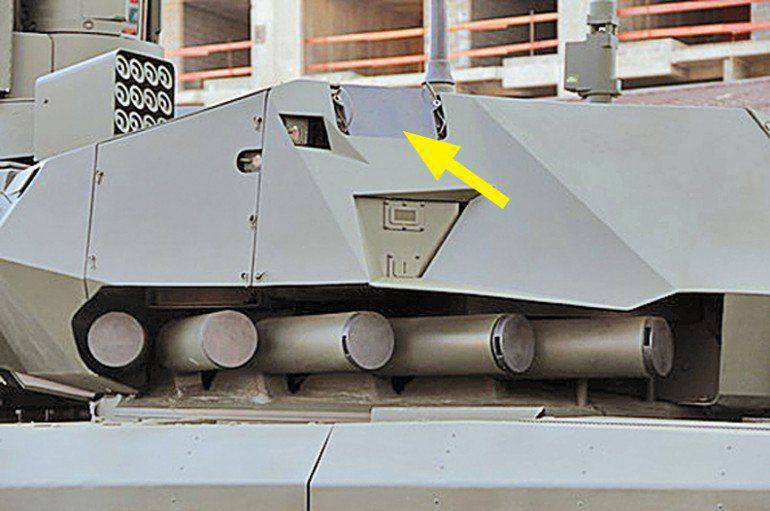
As a striking element, KAZ of the “Drozd” type uses a grenade with a fragmentation warhead, when undermined, a radial stream of fragments is created that is directed along the entire circumference. The projection of the target gets no more than 10 percent of the flow, which is clearly not enough to destabilize the cumulative projectile or sub-caliber armor-piercing projectile. The only targets of KAZ "Drozd" remain only rocket-propelled grenades and anti-tank missiles.
Alternatives to the KAZ of the Drozd type are the Russian Arena complex and the Israeli Trophy system. They belong to all-range systems, while the Russian complex has a zero time turning the launcher towards the target, the Israeli system - time, measured in tenths of a second. The tank gun at the same time is aimed at its goals regardless of the work of the KAZ.
As a striking element, alternative systems use firing plates of explosive with a metal lining, which, when exploded, produces a narrow stream of fragments, 90 percent of which are directed to the projection of the target. Only such systems with modernized metal cladding to form a shock core instead of a stream of fragments can in the long term intercept also heavy caliber and small-sized sub-caliber shells.
Thus, the KAZ of the type "Drozd" impairs the protection of the T-14 compared to other main battle tanks on which alternative active protection systems are installed or will be installed.
But maybe the lowered protection of the new tank is redeemed by the increased power of its weaponry? On the version presented to the public, the 125-mm gun 2А82, the muzzle energy of which corresponds to the 120-mm NATO gun with a barrel length 55 caliber, which is installed on the latest modifications of American and German tanks, is installed. There is a parity of armament, and no more.
True, the T-14 has an 152-mm 2А83 gun with an initial speed of 1980 m / s, but this potential is completely depreciated by the presence of several 140-mm guns in the arsenal of NATO countries, the muzzle energy of which is at the level of the Russian gun of a larger caliber . One of these guns has already been installed on the Abrams M1 serial tank with an upgraded turret and ATACS automatic loader. Consequently, the parity of armament will continue in the future.
In conclusion, it is necessary to touch the most advertised "chips" T-14 - providing the crew with 100-percent technical vision with the possibility of reducing the number of tank crews to two after the expansion of the onboard TIUS capability.
However, upon closer inspection, it becomes clear that technical vision is limited only to the installation of new surveillance devices - television / thermal cameras, placed around the perimeter of the hull. Except how to create a circular review, these cameras do not know how. The aiming of the gun on the target is carried out by the previously developed method - using a single panoramic sight with independent drive. This means that after selecting a target and putting it on autotracking while the turret is turning on the target, the panoramic sight is removed from work as a means of observation, since it continuously monitors the target until the second sight directly connected to the gun is put into operation.
It is necessary to quickly change the situation, remove the panoramic sight (bearing the well-deserved name “bucket” due to the volume of the armored hull), place high-quality cameras around the perimeter of the tower, which continuously form a circular panorama with a virtual aiming grid. Only then can the tank commander, having captured the target and set it to auto-follow for the period when the turret turns to the target, will be able to instantly switch to the search for the next target. Then you can exclude the operator-gunner from the crew and reduce the size of the control compartment.
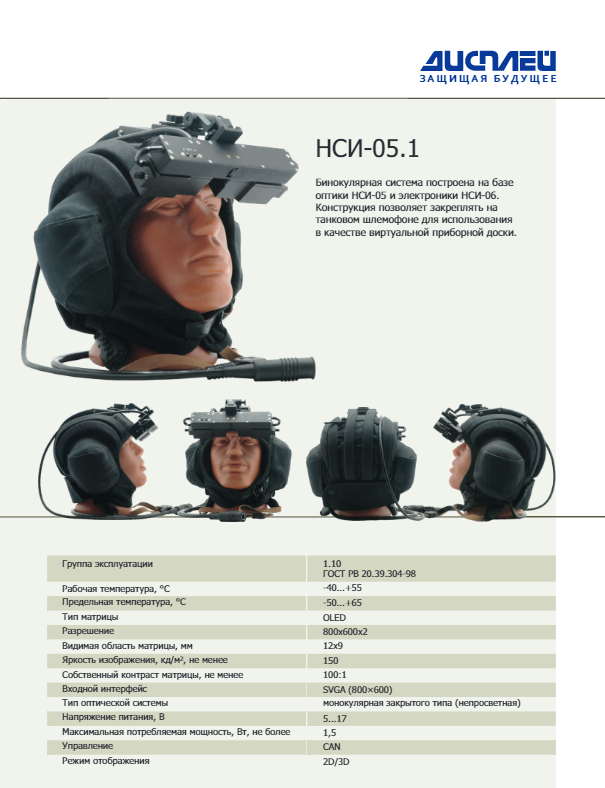
The increase in layout density will also be facilitated by the rejection of the use of tablet displays as a means of displaying information, the number and dimensions of which in the T-14 have reached the level of a home theater. It's time to switch to helmet-mounted devices by analogy with aviation or use the existing inexpensive binocular displays of the type NSI-05.1 manufactured by JSC Design Bureau Display (Republic of Belarus).
From the foregoing, it can be concluded that the technical solution of the T-14 needs to be fundamentally processed in order to eliminate the backlog of modern modifications of the main battle tanks.
First, it is required to lower the height of the tank on the hull roof from 1,8 to 1,4 meter within the internal dimension required for the vertical placement of new 125-mm projectiles (900 mm in length) in the turret loader.
Secondly, it is required to use a low-profile armored turret without an external casing instead of the current high-profile one with the placement of all KAZ launchers, electronic components of sights and observation devices inside the tower, and not in a light-armored casing.
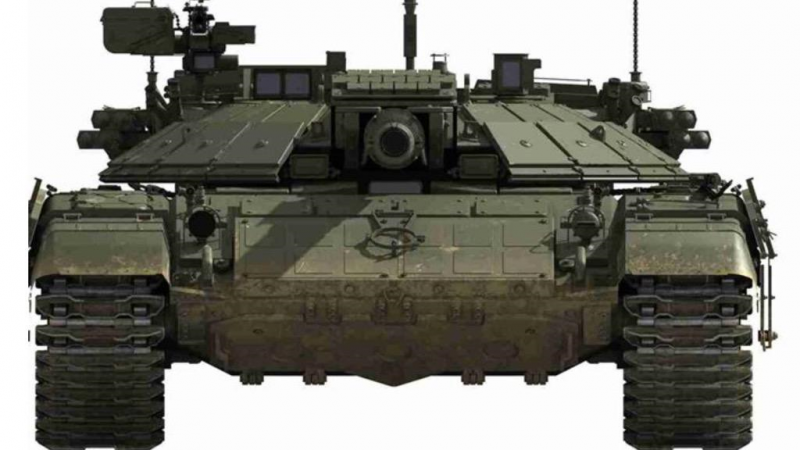
Thirdly, it is necessary to significantly compact the layout of the hull, thereby reducing its length and moving to the chassis of six pairs of road wheels, which will reduce the parasitic space and weight of the undercarriage of the tank.
Fourthly, it is required to replace the KAZ of the type “Drozd” with an all-view active protection system, possessing zero time of aiming at the target and using a striking element in the form of a shock core.
It remains unclear how much UVZ is capable of carrying out such optimization of the T-14 design, even taking into account the declared title of the Armath family as a unified tracked platform.
Information